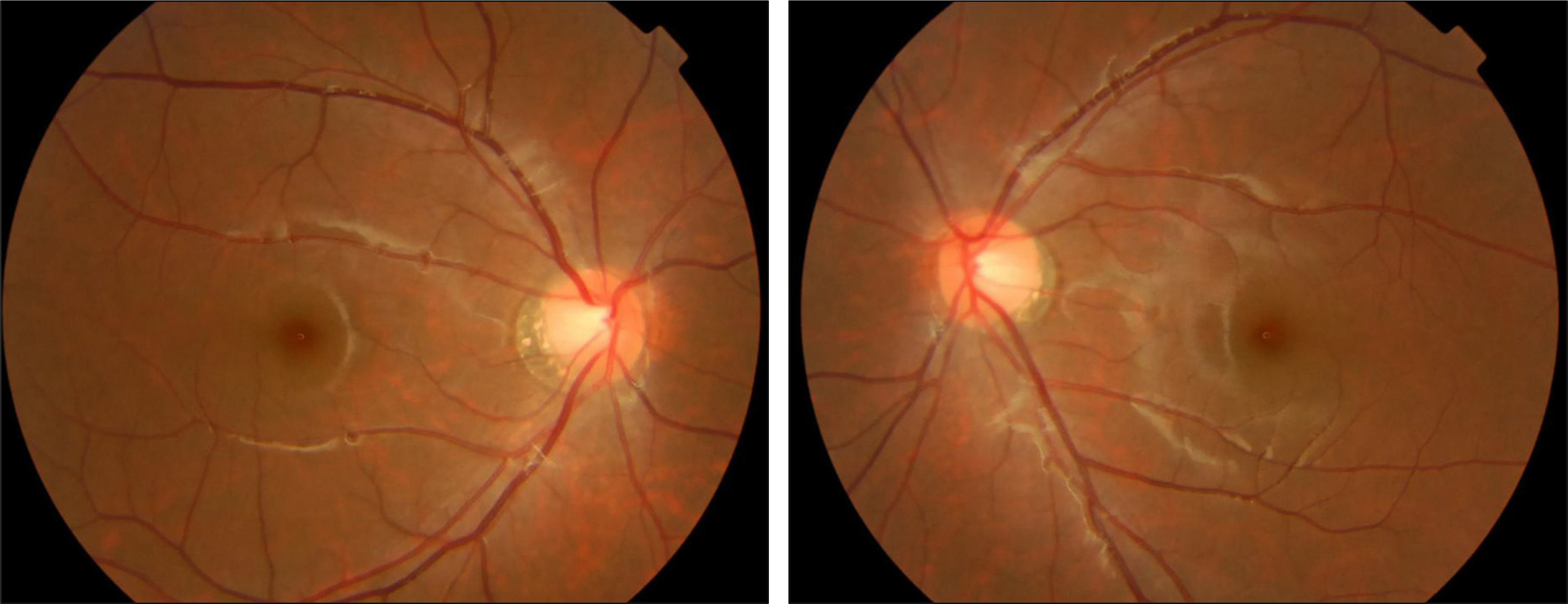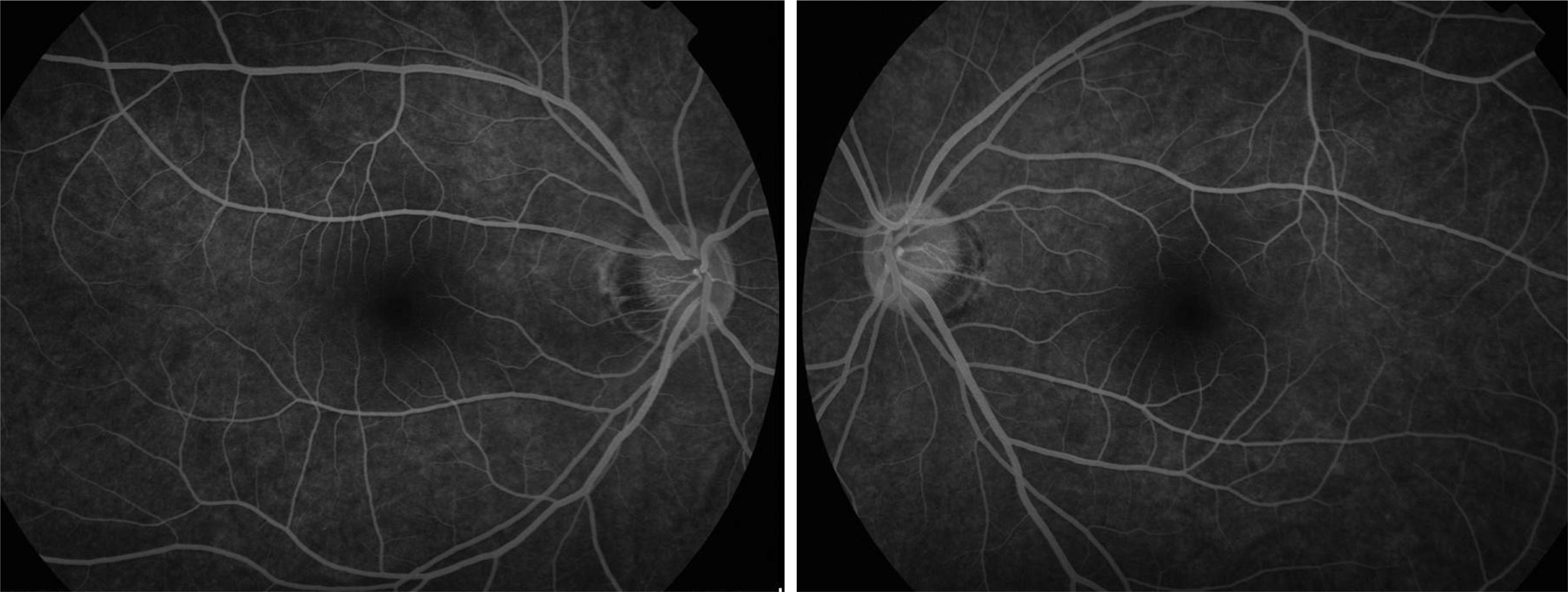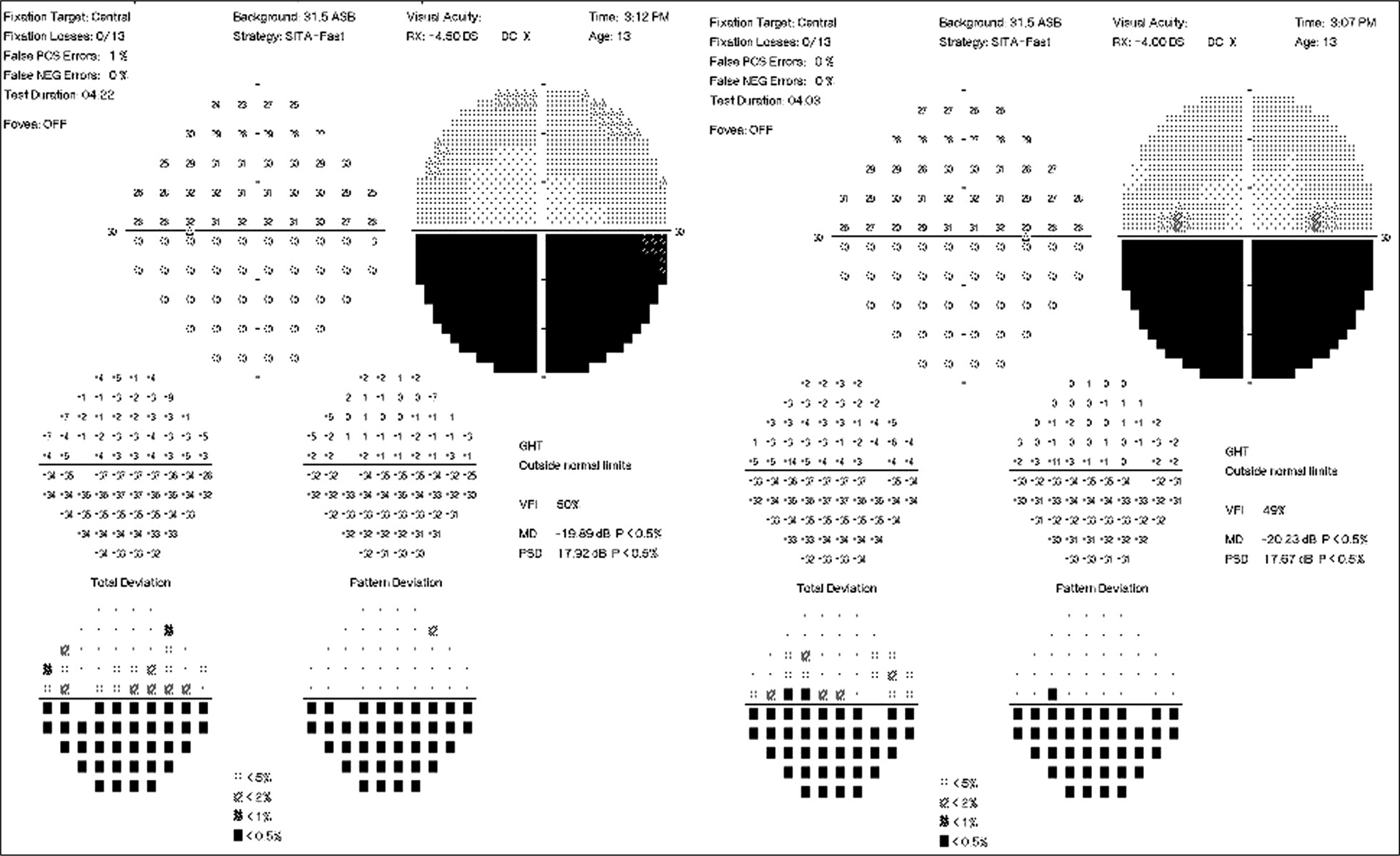J Korean Ophthalmol Soc.
2010 Nov;51(11):1537-1542. 10.3341/jkos.2010.51.11.1537.
A Case of Prolonged Bilateral Inferior Altitudinal Visual Field Defect in a Young Migraineur
- Affiliations
-
- 1Department of Ophthalmology, Asan Medical Center, University of Ulsan College of Medicine, Seoul, Korea. htlim@amc.seoul.kr
- KMID: 2213993
- DOI: http://doi.org/10.3341/jkos.2010.51.11.1537
Abstract
- PURPOSE
To report a case of prolonged bilateral inferior altitudinal visual field defect in a young migraine patient.
CASE SUMMARY
A 13-year-old female patient presented with bilateral disturbance of visual acuity and visual field, which had begun one month before. She complained of headache, with recently increasing frequency, that occurred 3 or 4 days a week for about 2~3 hours duration, sometimes accompanied by nausea and located in the frontotemporal and retrobulbar area. Brain magnetic resonance imaging showed no abnormal finding in the brain and orbit. Her visual acuity was hand motion in both eyes and Humphrey visual field test showed bilateral inferior altitudinal visual field defect. Pupillary resonse was normal and extraocular muscle movement, anterior segment and fundus were also normal in ophthalmologic examination. Her best corrected visual acuity was 1.0 in both eyes by fogging method, but bilateral inferior altitudinal visual field defect persisted for 6 months follow-up.
CONCLUSIONS
Bilateral inferior altitudinal visual field defect can be developed in a migraine patient without other causes. Careful examinations to rule out other causes such as ischemic optic neuropathy or brain infarct should be performed in a migraine patient who complains of visual disturbance.
Keyword
MeSH Terms
Figure
Cited by 1 articles
-
Clinical Features of Patients Complaining of Visual Symptoms and Diagnosed with Migraine
Joong Sik Koh, Seong Joon Kim
J Korean Ophthalmol Soc. 2015;56(12):1933-1938. doi: 10.3341/jkos.2015.56.12.1933.
Reference
-
References
1. Choi WJ, Chung J-Y, Lee DI, et al. Comparison of effectiveness of stellate ganglion block between chronic tension headache and chronic migraine patients. Korean J Anesthesiol. 2006; 51:201–6.
Article2. Lewis RA, Vijayan N, Watson C, et al. Visual field loss in migraine. Ophthalmology. 1989; 96:321–6.
Article3. Razeghinejad MR, Masoumpour M, Bagheri MH. Migrainous prolonged and reversible bilateral inferior altitudinal visual field defect. Headache. 2009; 49:773–6.
Article4. Relja G, Granato A, Ukmar M, et al. Persistent aura without infarction: description of the first case studied with both brain SPECT and perfusion MRI. Cephalalgia. 2005; 25:56–9.
Article5. Kang SJ, Kim JK, Kim MJ, et al. A case of recurrent and transient unilateral visual disturbance improved by beta-blocker: a variant of retinal migraine? Korean J Headache. 2007; 8:97–9.6. Falavarjani KG, Sanjari MS, Modarres M, Aghamohammadi F. Clinical profile of patients with nonarteritic anterior ischemic optic neuropathy presented to a referral center from 2003 to 2008. Arch Iran Med. 2009; 12:472–7.7. Mensah A, Vignal-Clermont C, Chadi M, et al. Dysthyroid optic neuropathy: Atypical initial presentation and persistent visual loss. Orbit. 2009; 28:354–62.
Article8. Lee AG, Brazis PW, Miller NR. Posterior ischemic optic neuropathy associated with migraine. Headache. 1996; 36:506–10.
Article9. González-Martín-Moro J, Pilo-de-la-Fuente B, Moreno-Martín P. Migraineous anterior optic ischemic neuropathy. Arch Soc Esp Oftalmol. 2009; 84:473–6.10. Trobe JD. The neurology of vision. New York: Oxford University Press;2001. p. 295.11. Tzourio C, Tehindrazanarivelo A, Iglésias S, et al. Case-control study of migraine and risk of ischaemic stroke in young women. BMJ. 1995; 310:830–3.
Article12. Agostoni E, Rigamonti A. Migraine and cerebrovascular disease. Neurol Sci. 2007; 28(Suppl 2):S156–60.
Article13. Trego ME, Pagani JM. Three presentations of monocular vision loss. Optometry. 2006; 77:82–7.
Article14. Streifler J-Y, Eliasziw M, Benavente OR, et al. North American Symptomatic Carotid Endarterectomy Trial. The risk of stroke with first-ever retinal vs hemispheric transient ischemic attacks and high-grade carotid stenosis. Arch Neurol. 1995; 52:246–9.15. Lashley KS. Patterns of cerebral integration indicated by the scotomas of migraine. Arch Neurol Psychiatry. 1941; 46:331–9.
Article16. Dahlem MA, Engelmann R, Lowel S, Muller SC. Does the migraine aura reflect cortical organization? Eur J Neurosci. 2000; 12:767–70.
Article17. Moskowitz MA. Basic mechanisms in vascular headache. Neurol Clin. 1990; 8:801–15.
Article18. Wilkins A, Nimmo-Smith I, Tait A, et al. A neurological basis for visual discomfort. Brain. 1984; 107:989–1017.
Article19. Wakakura M, Ichibe Y. Permanent homonymous hemianopias following migraine. J Clin Neuroophthalmol. 1992; 12:198–202.20. Luda E, Bo E, Sicuro L, et al. Sustained visual aura: a totally new variation of migraine. Headache. 1991; 31:582–3.
Article
- Full Text Links
- Actions
-
Cited
- CITED
-
- Close
- Share
- Similar articles
-
- A Case of Ota Nevus Associated with Altitudinal Field Defect
- Temporary amaurosis with persistent visual field defect following acute blood loss
- Monocular Superior Altitudinal Field defect due to Supraclinoid Internal Carotid Artery Aneurysm
- Bilateral Occipital Lobe Infarction Presenting as Bilateral Inferior Altitudinal Defects
- A Case of Non-Arteritic Anterior Ischemic Optic Neuropathy after Bilateral Selective Neck Dissection






